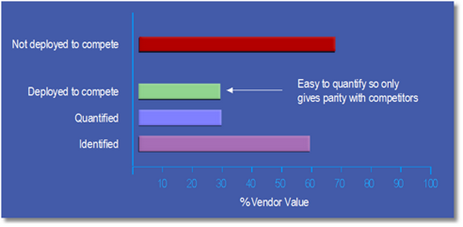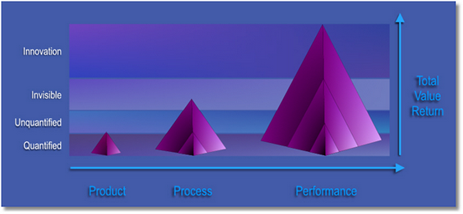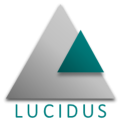
3.Introduction
This is the third in a series of articles brought to you by Robert White - CEO of Lucidus Ltd dealing with the subject of 'Value' in the sales process.
In previous articles, we have described the problems of selling in the modern world and on spotting the symptoms that show you have the selling problem.
In this installment, we discuss why it is important to unlock value and what kinds of 'Value' you should be looking for.
Unidentified Value
First we should explain just how much customer value is routinely concealed from view, why this happens and why it is important to uncover it.
As a general rule, we find that most vendors have identified about 60% of their potential customer value - but can quantify only about 50% of what can be identified.
This means they can only compete with about 30% of their potential capability. And the trouble is that the 30% they can identify is the easier part - so easy, that their competitors have also figured it out - so everyone's back to parity - no advantage - no differentiation and potentially 70% of their capability still not deployed.

So - unlocking that potential 70% of value is absolutely key to differentiating your company because it will help to remove any customer uncertainty about the value of your products and services and will create in the customer a confidence to invest.
In fact, so important is this issue, its worth spending just a little more time to understand it better.
Each product or service will have its own intrinsic value - it'll be cheaper or run cheaper - it'll have some obvious attributes. But those attributes - its value - are confined to the product itself. If we place the product inside a process then the scope for value generation is widened - we can now make the process more effective and start to impact our customer's output. But if we then start to think about the performance effects of the process - both upstream and downstream - we start to influence the customers enterprise - and more importantly - the customer's customers - the source of all true value.
Types of Value
We see four quite distinct strands of value:
- Quantified value - the bit that everyone gets - so no real advantage
- Un-quantified value - that's the bit that everyone knows is there but can't quantify
- Invisible Value - you don't know its there. Your customers might know but they're keeping quiet in case you put up your prices - or more likely - they don't know either;
- value that springs from innovation

I'll need an example to illustrate:
One of our clients found that the resin they make for particle and other boards was under fierce pricing pressures.
By talking to their customers and their customer's customers, we discovered two end user problems to do with mold and the need for waterproofing. A simple and cheap change to the resin chemistry enabled our client's customer to create two new products - a mold free board for use in kitchens and bathrooms and a waterproof board that reduced waiting time after rain on building sites.
This meant that our client's customer could charge more for their board and would therefore accept a higher cost for the resin that made it possible. Sales of the new products were high so our client achieved a higher price for its product plus a significant increase in volume - both of which are good for profit growth and share price.
So - the key point here is that unless you can unlock that 70% of potential customer value, you will not differentiate yourself - and no amount of 'sales training' or tinkering with sales processes will make any real difference.
Next
In the next part we will discuss why it is important to unlock value and what kinds of 'Value' you should be looking for.

